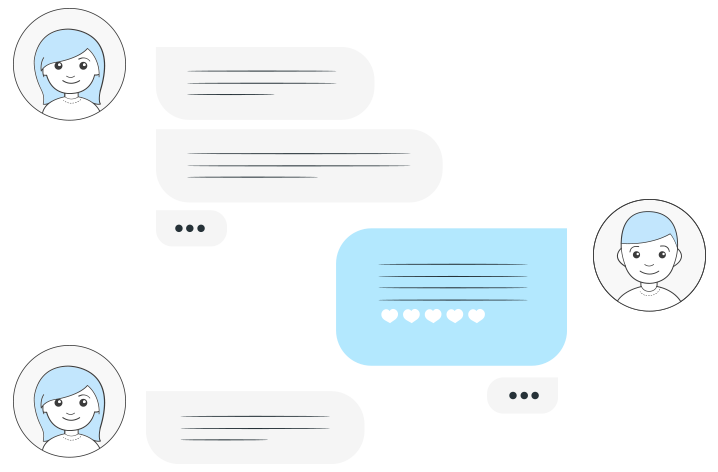Conversational messaging is a way to interact with customers using instant messaging channels, such as live chat, social media, or messaging apps like WhatsApp.
In this way, instead of using traditional methods such as email or telephone, conversational messaging allows faster and more direct communication with users.
The key to this type of messaging is real-time, two-way interaction, where customers can ask questions, get instant answers, and receive personalized assistance more quickly. All this, of course, helps to improve sales and the relationship with customers.
Benefits of conversational messaging
The benefits of conversational messaging are diverse and can have a significant impact on the customer experience and business performance. Let’s look at some key benefits along with examples to illustrate them:
1. Real-time communication
Conversational messaging enables instant communication between the company and customers, which improves efficiency and the user experience. Customers can get answers to their questions or solutions to their problems in real time, which increases satisfaction and trust in the brand.
Example: A customer has an urgent question about a product and uses the live chat on the company’s website to get an immediate response from a customer service representative.
2. Personalized attention
It also allows the personalization of interactions with customers. By using collected data and preferences, companies can offer personalized recommendations and offers, increasing the chances of conversion.
Example: A customer searches for a new phone on the website of an electronic store. Use live chat to receive personalized advice from an agent who, using collected data and preferences, offers options that fit your needs and budget. The agent provides recommendations based on the customer’s purchasing history and offers her a special offer on a model that perfectly fits her preferences.
The customer feels impressed with the personalized attention and the exclusive offer, which is why they make the purchase through live chat, thanking them for the help received and showing their satisfaction with the experience.
This article, 5 tips to improve customer service by WhatsApp Business delves into how to use this platform to improve customer service.
3. 24/7 Availability
You can be available 24/7, even through the use of smart chatbots. This allows customers to get support at any time, which improves satisfaction and retention.
Example: An international customer has a query about an order over the weekend. Although the physical store is closed, you can use the live chat or the chatbot on the website to get immediate answers.
4. Improved customer retention
Fast, personalized attention delivered through conversational messaging can increase customer loyalty. Customers who receive excellent service tend to return and recommend the brand to others.
Example: An e-commerce company offers a loyalty program to its most active customers. Through conversational messaging, notify members of reward points earned and exclusive offers, which incentivizes customers to keep shopping.
5. Facilitates the buying process
Conversational messaging can help customers at every stage of the buying process, from initial research to checkout. This reduces friction and improves the conversion rate.
Example: A customer is looking for information about business software. Use the chat on the vendor’s website to get details about product features and pricing before you decide to buy.
In short, conversational messaging provides a smoother and more satisfying experience for customers, increases retention and loyalty, improves customer service efficiency, and ultimately can drive growth and sales for a business.

Types of conversational messaging
In the field of digital marketing and customer service, the types of conversational messaging can vary depending on the communication channels and platforms used. These are the most common:
Live Chat
It is one of the most popular types of conversational messaging. It allows customers to directly interact with customer service representatives in real time through a chat on the company’s website. Live chat provides instant answers to customer questions and concerns, which can increase satisfaction and improve conversion rates.
Chatbots
Artificial intelligence programs that can automatically respond to customer inquiries. They can simulate a human conversation and answer frequently asked questions or provide basic assistance without human intervention. Chatbots are especially useful for providing quick responses and maintaining 24/7 availability.
Instant messaging applications
These include popular services such as WhatsApp, Facebook Messenger, Telegram, among others. Businesses can use these platforms to interact with customers and send notifications, such as order confirmations or shipping updates. Some companies also use instant messaging applications to provide customer support.
Social networks
Social networks offer opportunities for conversational messaging through comments, direct messages or even interactive posts. Customers can communicate with the brand and vice versa, allowing for close interaction and quick response to concerns.
Conversational Email
This form of messaging is a variant of traditional email. Instead of using static and formal responses, conversational email focuses on personalization and direct interaction, creating a more conversational experience.
The main difference between traditional email and conversational email lies in their writing style and communication approach. While traditional email focuses on the formal transmission of information, conversational email seeks to establish a closer and more personalized communication, as if it were a face-to-face conversation.
Voice assistants and smart speakers
Conversational messaging is also spreading through devices like voice assistants (for example, Amazon Alexa, Google Assistant) and smart speakers. Users can interact with these devices to make purchases, get information, and perform tasks through natural conversation.
Each type of conversational messaging has its advantages and challenges, and choosing the most appropriate one will depend on the target audience and the business objectives of each company. Some businesses may choose to use multiple types of conversational messaging to provide a richer and more satisfying omnichannel experience for their customers.
How can you help improve sales?
Conversational messaging can be a powerful tool to improve a company’s sales due to its ability to provide faster, more personalized and accessible customer service. By offering the ability to interact in real time with customers, companies can immediately respond to customer questions and concerns, removing barriers and reducing uncertainty in the purchasing process.
This personalized attention also allows a better understanding of the customer’s needs and preferences, which makes it easier to offer more relevant product or service recommendations, increasing the chances of conversion.
But better let’s see through which strategies it is possible to achieve synergy with the client and increase the sales of a company:
Strategies to achieve effective synergy with the client
To achieve effective synergy with customers through conversational messaging, it is essential to focus on building strong and authentic relationships. Here are some key strategies to achieve that synergy:
1. Active listening
Show genuine interest in customer needs, questions, and comments. Actively listen to what they have to say during conversational messaging interactions and respond appropriately. This helps to establish a deeper connection and better understand their concerns and expectations.
2. Personalization
It refers to using the information we have about customers to offer personalized answers and recommendations. Conversational messaging provides the opportunity to provide a unique experience for each customer, making them feel valued and understood. Personalized interaction will enable closer and more personal communication with customers, increasing trust and satisfaction.
3. Quick and Accurate Responses
Conversational messaging is all about immediacy, so responding quickly to customer queries is essential. Provide accurate and helpful answers to ensure customers get what they need in a timely manner. By providing quick responses, barriers to purchasing decision making are reduced.
4. Empathy and kindness
Show empathy towards customers and kindness in responses. Warm and friendly communication creates a positive environment and encourages greater interaction and trust with the brand.
5. Intelligent Automation
Intelligently using chatbots and autoresponders to provide instant support when the customer support team is not available. However, these chatbots must be designed to provide relevant responses and offer the option to speak to a human representative if necessary.
6. Segmentation and retargeting
With conversational messaging, it is possible to collect information about customers and their preferences, allowing for more effective segmentation and personalized retargeting campaigns.
7. Offer added value
In addition to answering questions and providing support, consider providing additional content of value to customers. This could include how-to guides, tips, special discounts, or information about new products and services.
8. Encourage feedback
Ask customers for feedback on their experience with conversational messaging and how it could be improved. Listening to customer opinions will help adjust strategies and offer an increasingly satisfactory experience.
9. Maintain consistency in all channels
If you use several conversational messaging channels, you must maintain consistency in the way you communicate and in the information provided. This helps build a consistent brand image and avoids confusion for customers.
10. Be proactive
Start the conversation with your customers proactively. For example, by sending relevant notifications or messages about promotions, product updates, or events related to your interests.
By following these strategies, you will be able to achieve effective synergy with your customers through conversational messaging. A strong and positive relationship with customers can lead to increased retention, loyalty, and word-of-mouth promotion, which benefits the business in the long run.
How can Uniboxi help in this purpose?
Uniboxi is a conversational messaging tool that can be an effective solution to improve sales and communication with customers. Some of its features and benefits include:
- Channel centralization: Uniboxi allows you to manage all messaging interactions in one place, making it easy to track and manage customer conversations.
- Automation with chatbots: The tool offers intelligent chatbots that can automatically answer frequently asked questions, saving time and resources for the customer service team.
- Segmentation and personalization: Uniboxi allows customers to be segmented according to their preferences and purchasing behavior, which makes it easy to send personalized and relevant messages.
- Analytics and metrics: The tool provides data and analysis on customer interactions, allowing you to continuously improve your conversational messaging strategy and optimize conversions.
With the proper use of conversational messaging and the Uniboxi tool, it is possible to provide a more satisfactory customer service experience and improve business sales.

What is digital fatigue with conversational messaging and how to avoid it
Also known as “chat fatigue” or “chat fatigue,” it’s a term that describes the feeling of exhaustion or saturation that both customers and customer service agents can experience due to an excessive amount of interactions through messaging. conversational.
To avoid these issues, it is essential to manage agent workload, provide adequate support and training, implement chatbots for repetitive tasks, and set clear expectations about response times.
Some factors that can contribute to digital fatigue with conversational messaging include:
- Excessive volume of messages: Having to respond to a large number of messages in a short time can be overwhelming and exhausting for customer support agents.
- Expectations of immediate responses: Customers can expect instant responses due to the real-time nature of conversational messaging, which can put pressure on agents.
- Repeating Common Questions: Agents may receive many repetitive inquiries, which can make them feel like they are “repeating” the same answers.
- Complex or contentious interactions: Some conversations can be more difficult or tense, which can increase stress for agents.
- Lack of variety in tasks: If agents are only engaged in conversational messaging and do not have other varied tasks, they can feel monotonous and bored.
How to avoid digital fatigue with conversational messaging:
- Set workload limits: Monitor the workload of agents so they are not overwhelmed with too many interactions at once. Shifts or rotations can be implemented to distribute the workload.
- Use chatbots and autoresponders: To handle frequently asked questions and autoresponders for simple inquiries, freeing up agents to focus on more complex and personalized inquiries.
- Manage response expectations: Clearly communicate expected response times to customers. If instant responses cannot be provided, it is important to indicate this to avoid frustration.
- Offer training and support: Provide agents with the appropriate training to deal with complex and conflicting situations. Also provide them with the necessary support so that they feel supported in their work.
- Collect feedback and make improvements: Ask agents about their experience and look for opportunities to improve the customer service process.
- Diversify service channels: If feasible, offer multiple customer service channels, such as email or phone, so that customers can choose the one that is most convenient for them.
By implementing these strategies, you will be able to reduce digital fatigue with conversational messaging for both your customers and your customer service agents, which will improve the quality of the overall service experience and ultimately increase sales.

